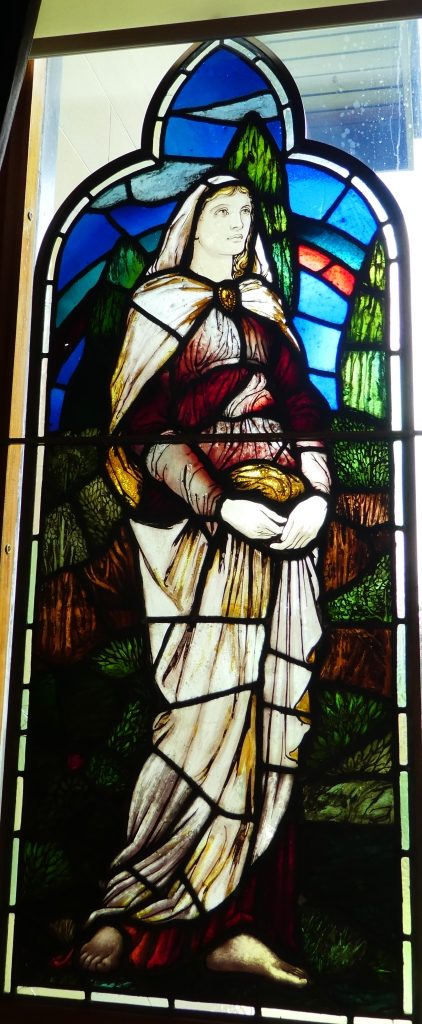In this latest blog, Heather Millard , our Social history curator discusses the latest addition to displays at Cliffe Castle
visitors to Cliffe Castle may have noticed a new addition to the window between our Grand Drawing Room and the Working Landscapes Gallery.
Nestled in the window, looking over the park are a rather lovely set of Arts and Crafts windows that we have recently installed. We thought we’d use this blog to tell you a little bit more about them.
They were originally installed in the church of St James, Brighouse. When the church was demolished in 1970 they were acquired by Bradford Museums and Galleries and taken into safekeeping.

The windows commemorate the life of Mrs Marianne Barber. Born into the Thackwray family of Knaresborough, Marianne married solicitor Joseph Barber in 1832. She had eight children and was widowed in 1862 when her husband was killed by a locomotive. It is thought that her children (who included the Venerable Edward Barber, Archdeacon of Chester Cathedral and Judge William Barber QC) commissioned the window in 1879.
The figures represent the interrelated religious ideas of Faith (left) and Hope (right) .

The artist has shown Hope looking upwards with a rainbow behind her.

Faith looks towards Hope. She rests one hand on a marble column while her left hand is raised in worship. A castellated tower acts as a backdrop. The artist’s signature is at the bottom left of the Faith panel.

In the Quatrefoil, Faith is shown as an angel bearing a staff in the form of a cross. The angel of Hope carries a shield decorated with an anchor.

Originally the Faith and Hope panels were positioned beside each other with the quatrefoil above. Display limitations at Cliffe Castle have required us to show the panels on the same line.
The windows were made by the firm of S. Belham and Co. of 155 Buckingham Palace Road, London, a company founded by Stephen Belham in 1865.
The window was designed and painted by Hugh Arthur Kennedy. Kennedy was an artist, playwright, novelist and journalist who studied Fine Art at the Slade School under Sir Edward Poynter. He wrote articles on stained glass (amongst many other topics) and worked with S. Belham and Co. and the well-known West Yorkshire designer J. Aldam Heaton who lived at Woodbank , Bingley.
The coloured, textured and marbled hand-made glass which forms the window was made by the celebrated glass and mosaic maker, Jesse Rust of the Lambeth Glass Works, London.
On the 6th December 1879 the windows were reviewed in the influential Victorian art magazine the Athenaeum. They described the windows as follows:
The drawing of the figures is strongly marked and the colour subdued. The works have been executed faithfully according to the true principals of glass staining and design in glass. There is repose and sobriety in the figures . . . and above all, sober, rich and jewel-like colouring of rare beauty.
In 2017 the windows were conserved and installed at Cliffe Castle by Jonathan and Ruth Cooke of Ilkley.
Funding for the project was made possible thanks to the generosity of the Revd Michael Belham, Miss Diana Kennedy and Mr John Atter (descendants of the manufacturer, the artist and the original donor’s family) and a conservation grant from the Glaziers Trust.
We’re also grateful to the families for providing us with additional information on the various individuals associated with the window. Art is beautiful – as are these fantastic windows, but as a Social History curator, also having the stories associated with it makes, I think, for a richer experience!
The museum is also grateful for the encouragement and support of the late Dr Neil Moat, a passionate champion of the work of H.A. Kennedy and S. Belham and Co.